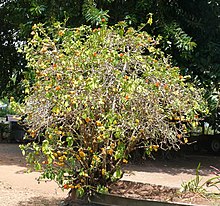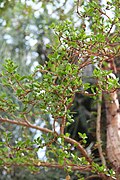| Leuenbergeria | |
|---|---|

| |
| Leuenbergeria bleo | |
| Scientific classification | |
| Kingdom: | Plantae |
| Clade: | Tracheophytes |
| Clade: | Angiosperms |
| Clade: | Eudicots |
| Order: | Caryophyllales |
| Family: | Cactaceae |
| Subfamily: | Leuenbergerioideae Mayta & Mol.Nov. |
| Genus: | Leuenbergeria Lodé |
| Type species | |
| Leuenbergeria quisqueyana | |
Leuenbergeria is a genus of flowering plant in the family Cactaceae, mostly native around the Caribbean. Unlike most cacti, it has persistent leaves and develops bark on its stems early in its growth. The genus was created in 2012 by Joël Lodé. Before the creation of Leuenbergeria as a genus, the species within it were included in a broadly circumscribed genus, Pereskia. Leuenbergeria is the only genus in the subfamily Leuenbergerioideae.
Description
Species of Leuenbergeria grow as trees or shrubs, up to 10 m (33 ft) in the case of L. lychnidiflora. They differ from most cacti in having leaves even when mature – as also do species of Pereskia and Rhodocactus, with which Leuenbergeria species were once united in a single genus. Leuenbergeria differs from those other genera in that the stems of Leuenbergeria species form bark at an early stage in their growth and do not have stomata, preventing them from acting as organs of photosynthesis. Like other cacti, they have areoles bearing spines. In most species, the areoles also bear leaves. Their flowers are mostly pink, orange or red, although some species have yellow flowers.
Taxonomy
Main article: Pereskia § Phylogeny and evolutionJoël Lodé created the genus Leuenbergeria in 2012. The name honours the Swiss botanist Beat Ernst Leuenberger. The genus Pereskia was previously broadly defined so that it included Leuenbergeria. Molecular phylogenetic studies suggested that there were three clades within Pereskia when circumscribed in this way. Leuenbergeria was created for the "Northern clade". By 2016, all three clades were recognized as separate genera. A consensus cladogram from a 2005 study is shown below with the more recent generic assignments added. It shows that the three genera are basal to the rest of the cacti.
|
Pereskia as previously defined |
Leuenbergeria has been placed as the only genus in the subfamily Leuenbergerioideae.
Within the genus, a 2005 molecular phylogenetic study suggested the species were related as shown in the following cladogram. The position of the ovary appears to have some phylogenetic significance. The sister species L. aureiflora and L. guamacho are the only two with yellow flowers.
|
semi-inferior ovary inferior ovary |
Species
As of May 2019, Plants of the World Online accepted eight species:
| Image | Scientific name | Distribution |
|---|---|---|
| Leuenbergeria aureiflora (F.Ritter) Lodé | eastern Brazil | |
 |
Leuenbergeria bleo (Kunth) Lodé | Panama and Colombia |
 |
Leuenbergeria guamacho (F.A.C.Weber) Lodé | S. Caribbean, N. Colombia to Venezuela |
 |
Leuenbergeria lychnidiflora (DC.) Lodé | Mexico (Guerrero, Oaxaca) to Central America |
 |
Leuenbergeria marcanoi (Areces) Lodé | Hispaniola (Dominican Republic) |
| Leuenbergeria portulacifolia (L.) Lodé | Hispaniola (Haiti) | |
 |
Leuenbergeria quisqueyana (Alain) Lodé | Hispaniola (Dominican Republic) |
 |
Leuenbergeria zinniiflora (DC.) Lodé | Cuba |
Distribution
Leuenbergeria has a discontinuous distribution. Most species are native to southwest Mexico and around the Caribbean, in both the West Indies and northern South America. L. aureiflora is the exception, being found in eastern Brazil.
References
- ^ "Leuenbergeria Lodé", Plants of the World Online, Royal Botanic Gardens, Kew, retrieved 2019-05-27
- ^ Mayta, Luis & Molinari-Novoa, E.A. (2015), "L'intégration du genre Leuenbergeria Lodé dans sa propre sous-famille, Leuenbergerioideae Mayta & Mol. Nov., subfam. nov.", Succulentopi@ (in French), 15: 6–7, retrieved 2015-01-20
- ^ Lodé, J. (2013), "Leuenbergeria, un nouveau genre de cactées", Cactus-Aventures International (in French), 97: 26–27, cited in Mayta & Molinari-Novoa (2015); English translation: Lodé, J. (2013), "Leuenbergeria, a new genus in Cactaceae", International Cactus-Adventures, 97: 25–27, retrieved 2021-04-28
- Anderson, Edward F. (2001), "Pereskia", The Cactus Family, Pentland, Oregon: Timber Press, pp. 566–572, ISBN 978-0-88192-498-5; Anderson's Pereskia includes Leuenbergeria.
- "Plant Name Details for Leuenbergeria Lodé", The International Plant Names Index, retrieved 2019-05-27
- Bárcenas, Rolando T.; Yesson, Chris & Hawkins, Julie A. (2011), "Molecular systematics of the Cactaceae", Cladistics, 27 (5): 470–489, doi:10.1111/j.1096-0031.2011.00350.x, PMID 34875796, S2CID 83525136
- Asai, Issaku & Miyata, Kazunori (2016), "An Emendation of Rhodocactus, a Genus Segregated from Pereskia (Cactaceae)" (PDF), Journal of Japanese Botany, 91: 7–12, retrieved 2021-04-25
- ^ Edwards, Erika J.; Nyffeler, Reto & Donoghue, Michael J. (2005), "Basal cactus phylogeny: implications of Pereskia (Cactaceae) paraphyly for the transition to the cactus life form", American Journal of Botany, 92 (7): 1177–1188, doi:10.3732/ajb.92.7.1177, PMID 21646140
| Taxon identifiers | |
|---|---|
| Leuenbergeria | |